Abstract
Myxococcus xanthus is a Gram-negative bacterium that aggregates to form fruiting bodies when nutrients are limiting. Previous studies showed that the frz mutants that are defective in chemotaxis exhibited irregular and infrequent patterns of cellular reversal. In contrast, wild-type cells, when examined individually, reverse relatively frequently, about once every 6 min. It is not known how the change of reversal frequency effects cellular aggregation during fruiting body formation in M. xanthus. In this study, we stained cells with a tetrazolium dye so that we could track the reversal frequencies of single cells and cells in groups. We found that developmental cells in large groups reverse much less than cells in small groups or as single cells. This reduced cellular reversal frequency is related to the frz signal transduction system and correlated with the methylation of FrzCD (a methyl-accepting chemotaxis protein). Cells containing a mutation in the frz genes or in the genes required for social motility do not respond in this way. The reduction in cellular reversals as developmental cells accumulate in groups suggests a simple hypothesis for the aggregation of cells into discrete mounds during fruiting body formation. We also found that M. xanthus cells glide with equal frequency in the forward or reverse directions, indicating that cells do not contain a "head" or "tail."
Full text
PDF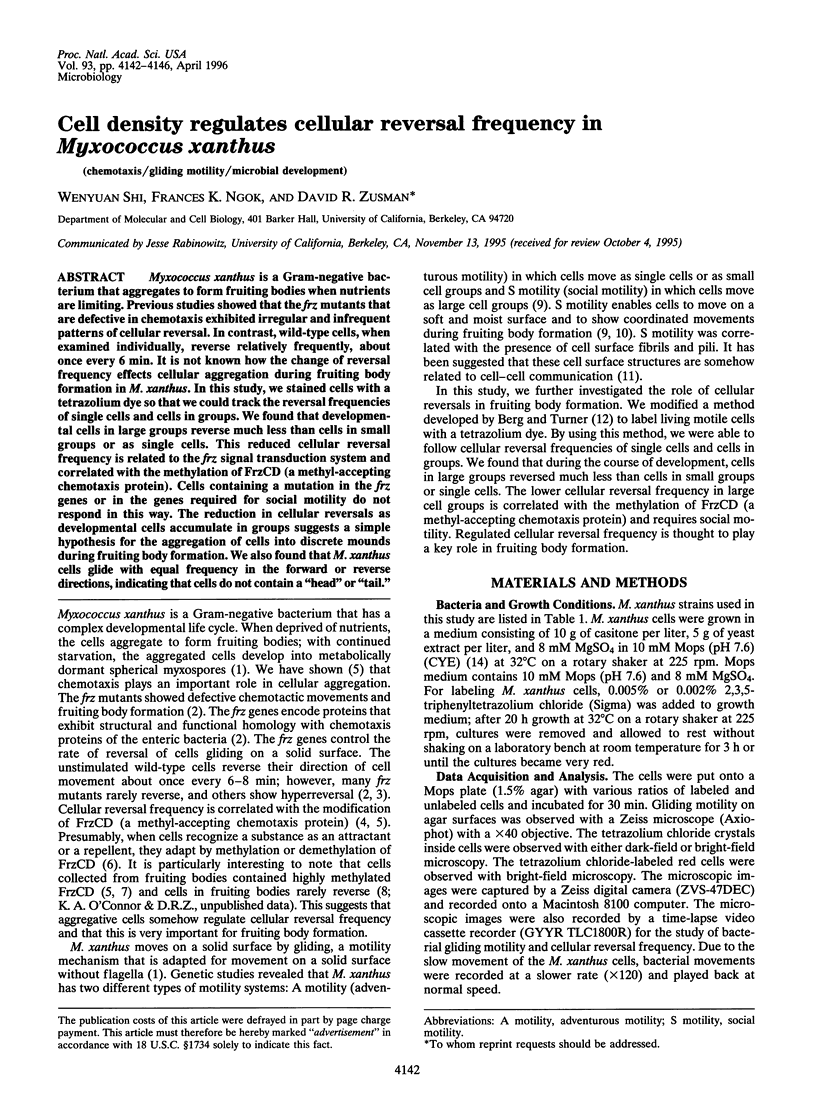
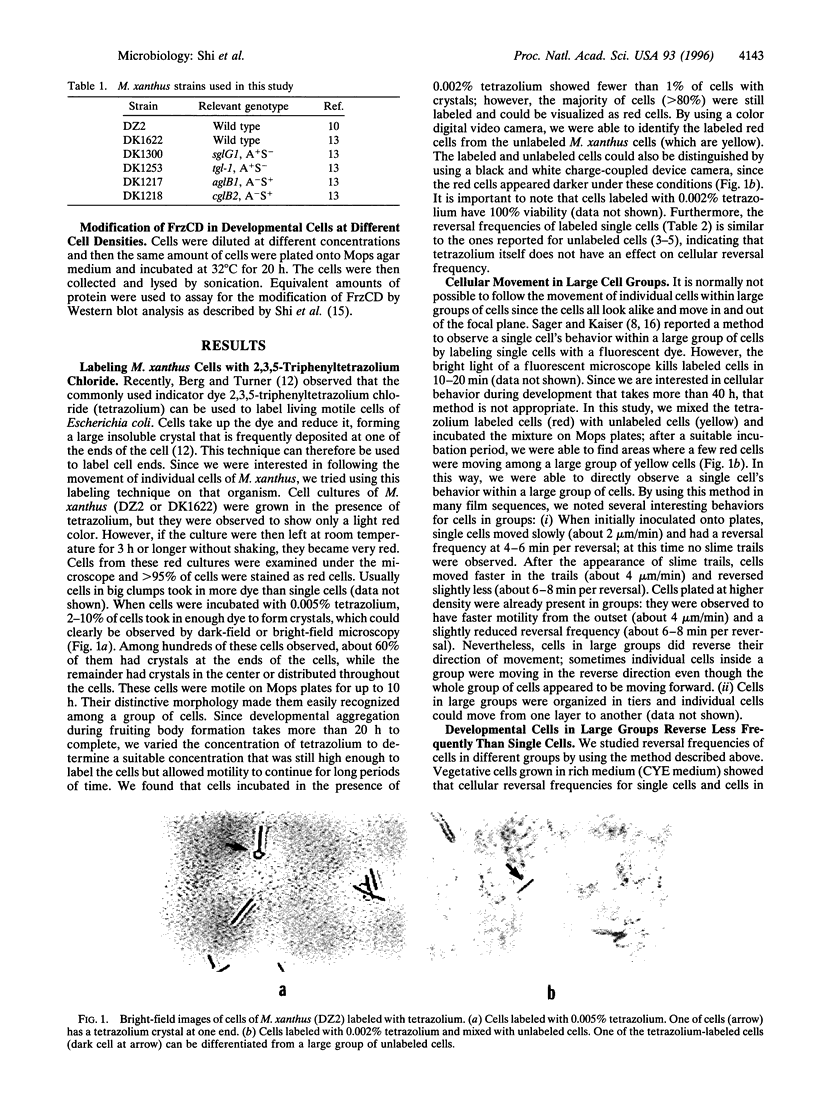
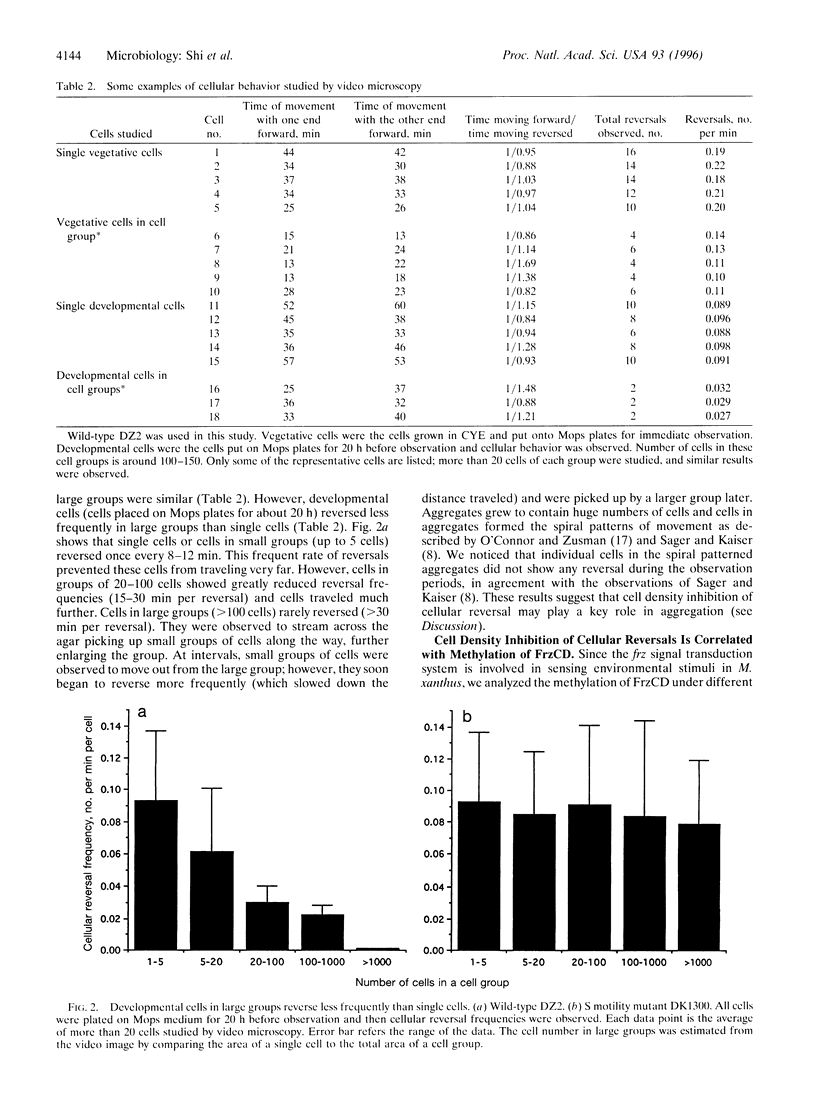
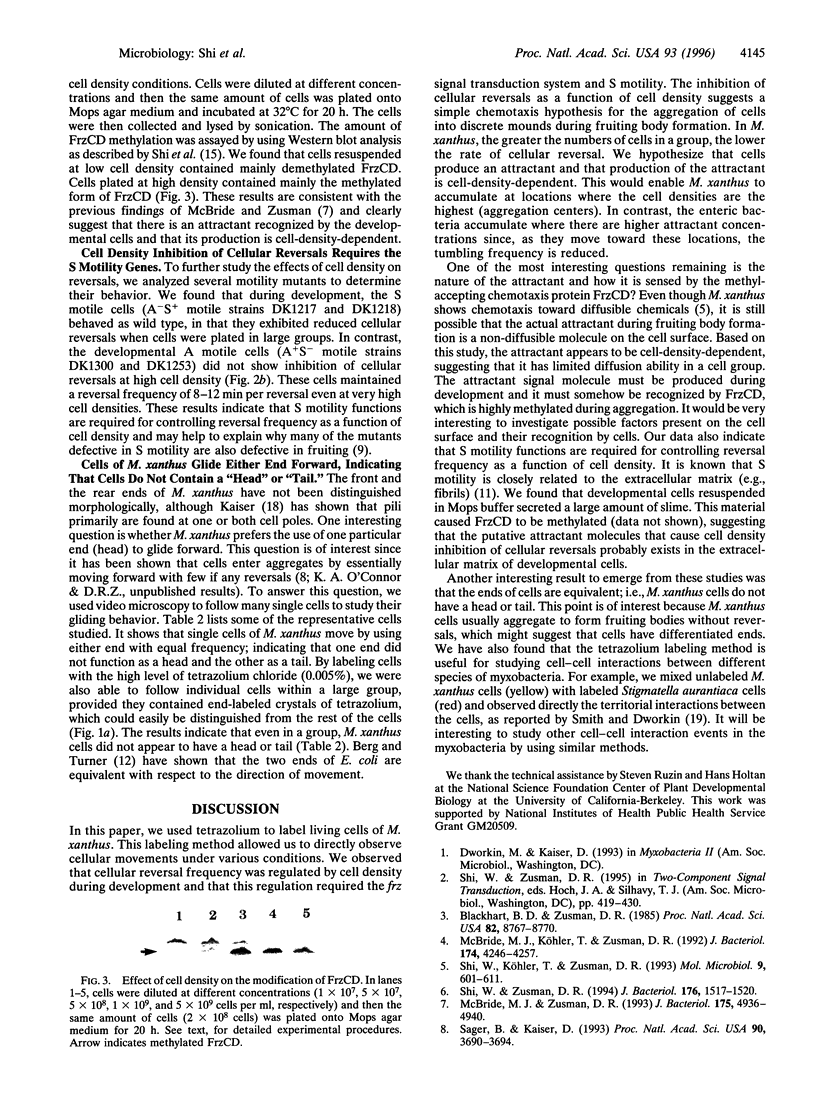
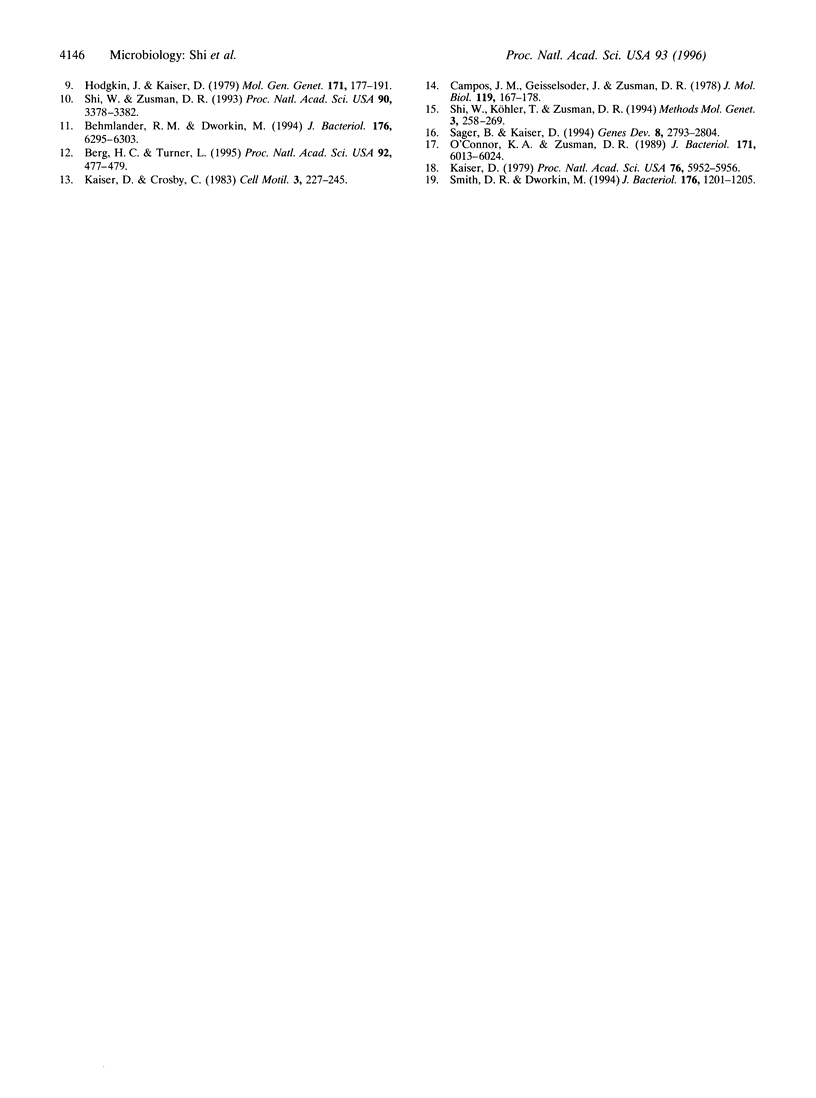
Images in this article
Selected References
These references are in PubMed. This may not be the complete list of references from this article.
- Behmlander R. M., Dworkin M. Biochemical and structural analyses of the extracellular matrix fibrils of Myxococcus xanthus. J Bacteriol. 1994 Oct;176(20):6295–6303. doi: 10.1128/jb.176.20.6295-6303.1994. [DOI] [PMC free article] [PubMed] [Google Scholar]
- Berg H. C., Turner L. Cells of Escherichia coli swim either end forward. Proc Natl Acad Sci U S A. 1995 Jan 17;92(2):477–479. doi: 10.1073/pnas.92.2.477. [DOI] [PMC free article] [PubMed] [Google Scholar]
- Blackhart B. D., Zusman D. R. "Frizzy" genes of Myxococcus xanthus are involved in control of frequency of reversal of gliding motility. Proc Natl Acad Sci U S A. 1985 Dec;82(24):8767–8770. doi: 10.1073/pnas.82.24.8767. [DOI] [PMC free article] [PubMed] [Google Scholar]
- Campos J. M., Geisselsoder J., Zusman D. R. Isolation of bacteriophage MX4, a generalized transducing phage for Myxococcus xanthus. J Mol Biol. 1978 Feb 25;119(2):167–178. doi: 10.1016/0022-2836(78)90431-x. [DOI] [PubMed] [Google Scholar]
- Kaiser D. Social gliding is correlated with the presence of pili in Myxococcus xanthus. Proc Natl Acad Sci U S A. 1979 Nov;76(11):5952–5956. doi: 10.1073/pnas.76.11.5952. [DOI] [PMC free article] [PubMed] [Google Scholar]
- McBride M. J., Köhler T., Zusman D. R. Methylation of FrzCD, a methyl-accepting taxis protein of Myxococcus xanthus, is correlated with factors affecting cell behavior. J Bacteriol. 1992 Jul;174(13):4246–4257. doi: 10.1128/jb.174.13.4246-4257.1992. [DOI] [PMC free article] [PubMed] [Google Scholar]
- McBride M. J., Zusman D. R. FrzCD, a methyl-accepting taxis protein from Myxococcus xanthus, shows modulated methylation during fruiting body formation. J Bacteriol. 1993 Aug;175(15):4936–4940. doi: 10.1128/jb.175.15.4936-4940.1993. [DOI] [PMC free article] [PubMed] [Google Scholar]
- O'Connor K. A., Zusman D. R. Patterns of cellular interactions during fruiting-body formation in Myxococcus xanthus. J Bacteriol. 1989 Nov;171(11):6013–6024. doi: 10.1128/jb.171.11.6013-6024.1989. [DOI] [PMC free article] [PubMed] [Google Scholar]
- Sager B., Kaiser D. Intercellular C-signaling and the traveling waves of Myxococcus. Genes Dev. 1994 Dec 1;8(23):2793–2804. doi: 10.1101/gad.8.23.2793. [DOI] [PubMed] [Google Scholar]
- Sager B., Kaiser D. Two cell-density domains within the Myxococcus xanthus fruiting body. Proc Natl Acad Sci U S A. 1993 Apr 15;90(8):3690–3694. doi: 10.1073/pnas.90.8.3690. [DOI] [PMC free article] [PubMed] [Google Scholar]
- Shi W., Köhler T., Zusman D. R. Chemotaxis plays a role in the social behaviour of Myxococcus xanthus. Mol Microbiol. 1993 Aug;9(3):601–611. doi: 10.1111/j.1365-2958.1993.tb01720.x. [DOI] [PubMed] [Google Scholar]
- Shi W., Zusman D. R. Sensory adaptation during negative chemotaxis in Myxococcus xanthus. J Bacteriol. 1994 Mar;176(5):1517–1520. doi: 10.1128/jb.176.5.1517-1520.1994. [DOI] [PMC free article] [PubMed] [Google Scholar]
- Shi W., Zusman D. R. The two motility systems of Myxococcus xanthus show different selective advantages on various surfaces. Proc Natl Acad Sci U S A. 1993 Apr 15;90(8):3378–3382. doi: 10.1073/pnas.90.8.3378. [DOI] [PMC free article] [PubMed] [Google Scholar]
- Smith D. R., Dworkin M. Territorial interactions between two Myxococcus Species. J Bacteriol. 1994 Feb;176(4):1201–1205. doi: 10.1128/jb.176.4.1201-1205.1994. [DOI] [PMC free article] [PubMed] [Google Scholar]




